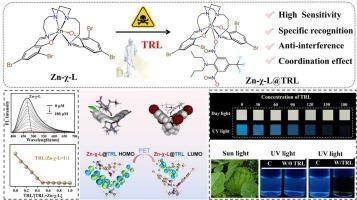独特的半球配位驱动农药残留探针:增强三氟拉林线性识别的稳定性
IF 12.2
1区 环境科学与生态学
Q1 ENGINEERING, ENVIRONMENTAL
引用次数: 0
摘要
三氟拉林(Trifluralin,TRL)是一种有效的持久性除草剂,但其广泛而长期的使用对生态和环境造成了越来越大的健康风险,因此开发方便快捷的三氟拉林检测方法对环境保护和食品安全至关重要。本研究设计并开发了一种新型荧光探针 Zn-χ-L,用于在复杂环境中快速、选择性地检测 TRL。该传感器具有出色的灵敏度和稳定性,同时对其他杀虫剂和金属离子的干扰也有很强的抗性。此外,Zn-χ-L 在各种溶剂中都表现出稳定的性能,并能抵抗其他农药和金属离子的干扰。分子对接和理论计算表明,Zn-χ-L 对 TRL 分子的独特识别能力与其特殊的半球形结构特征有关,它通过配位键、π-π 堆积和卤素键在 Zn-χ-L 与 TRL 之间形成了强烈的配位相互作用。这种特殊的构象不仅能形成配位键,还能在 Zn-χ-L 和 TRL 之间建立多重 π-π 堆积和卤素键相互作用,从而实现高效的电荷转移和优异的探针性能。本文章由计算机程序翻译,如有差异,请以英文原文为准。

Unique Hemispherical Coordination-Drivened Pesticide Residue Probes: Enhanced Stability in Linear Recognition for Trifluralin
Trifluralin (TRL) is an effective and persistent herbicide, but its extensive and prolonged use has increasingly posed ecological and environmental health risks, making the development of convenient and rapid TRL detection methods essential for environmental protection and food safety. In the present research, a novel fluorescent probe was designed and developed, Zn-χ-L, for the rapid and selective detection of TRL in complex environments. The sensor demonstrates excellent sensitivity and stability, while also exhibiting significant resistance to interference from other pesticides and metal ions. Moreover, Zn-χ-L exhibited stable performance across various solvents and showed resistance to interference from other pesticides and metal ions. Molecular docking and theoretical calculations indicate that the unique recognition of TRL molecules by Zn-χ-L is related to its specific hemispheric structural feature, which forms strong coordination interactions between Zn-χ-L and TRL through coordination bonds, π-π stacking, and halogen bonds. This special conformation not only enables the formation of coordination bonds but also establishes multiple π-π stacking and halogen bonding interactions between Zn-χ-L and TRL, leading to efficient charge transfer and exceptional probe performance.
求助全文
通过发布文献求助,成功后即可免费获取论文全文。
去求助
来源期刊

Journal of Hazardous Materials
工程技术-工程:环境
CiteScore
25.40
自引率
5.90%
发文量
3059
审稿时长
58 days
期刊介绍:
The Journal of Hazardous Materials serves as a global platform for promoting cutting-edge research in the field of Environmental Science and Engineering. Our publication features a wide range of articles, including full-length research papers, review articles, and perspectives, with the aim of enhancing our understanding of the dangers and risks associated with various materials concerning public health and the environment. It is important to note that the term "environmental contaminants" refers specifically to substances that pose hazardous effects through contamination, while excluding those that do not have such impacts on the environment or human health. Moreover, we emphasize the distinction between wastes and hazardous materials in order to provide further clarity on the scope of the journal. We have a keen interest in exploring specific compounds and microbial agents that have adverse effects on the environment.
 求助内容:
求助内容: 应助结果提醒方式:
应助结果提醒方式:


